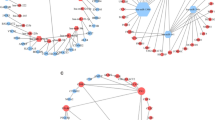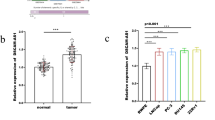Abstract
Osteosarcoma (OS) has become one of the most common primary malignant tumors in the children and adolescents with a poor prognosis mainly due to high metastasis. A disintegrin and metalloprotease 9 (ADAM-9) plays a role in tumorigenesis, invasion, and metastasis in several tumors. miR-126 has been reported to be downregulated in OS tumor. However, the involvement of ADAM-9 in the pathology of OS and the relationship between miR-126 and ADAM-9 in OS cells remain unclear. In this study, using quantitative reverse-transcribed PCR (qRT-PCR) analysis on 37 pairs of OS tumors and matched adjacent normal bone tissues, we found that ADAM-9 is significantly upregulated, while miR-126 is downregulated in human OS tumors. Association analysis revealed that upregulation of ADAM-9 and downregulation of miR-126 are significantly involved in advanced clinical stage development and distant metastasis. Luciferase reporter assay revealed that miR-126 could directly target ADAM-9 3′ untranslated region (UTR) and inhibit its expression in U2OS and MG-63 cells. Functional experiments revealed that downregulating ADAM-9 by miR-126 inhibited cellular growth, invasion, and migration in U2OS and MG-63 cells. In rescue experiments, restored ADAM-9 expression attenuated miR-126-mediated suppression, while knockdown of ADAM-9 by small interfering RNA (siRNA) represented similar results with miR-126-mediated tumor suppression in U2OS cells. Taken together, our data indicated that miR-126 inhibits cell growth, invasion, and migration of OS cells by downregulating ADAM-9.





Similar content being viewed by others
References
Kager L, Potschger U, Bielack S. Review of mifamurtide in the treatment of patients with osteosarcoma. Ther Clin Risk Manag. 2010;6:279–86.
Wolfsberg TG, Primakoff P, Myles DG, White JM. Adam, a novel family of membrane proteins containing a disintegrin and metalloprotease domain: multipotential functions in cell-cell and cell-matrix interactions. J Cell Biol. 1995;131:275–8.
Edwards DR, Handsley MM, Pennington CJ. The ADAM metalloproteinases. Mol Asp Med. 2008;29:258–89.
Duffy MJ, McKiernan E, O’Donovan N, McGowan PM. Role of ADAMs in cancer formation and progression. Clinic Cancer Res Off J Am Assoc Cancer Res. 2009;15:1140–4.
Alfandari D, McCusker C, Cousin H. Adam function in embryogenesis. Semin Cell Dev Biol. 2009;20:153–63.
Zhang J, Qi J, Chen N, Fu W, Zhou B, He A. High expression of a disintegrin and metalloproteinase-9 predicts a shortened survival time in completely resected stage I non-small cell lung cancer. Oncol Lett. 2013;5:1461–6.
Li J, Ji Z, Qiao C, Qi Y, Shi W. Overexpression of ADAM9 promotes colon cancer cells invasion. J Invest Surg. 2013.
Sung SY, Kubo H, Shigemura K, Arnold RS, Logani S, Wang R, et al. Oxidative stress induces ADAM9 protein expression in human prostate cancer cells. Cancer Res. 2006;66:9519–26.
Govoni KE, Amaar YG, Kramer A, Winter E, Baylink DJ, Mohan S. Regulation of insulin-like growth factor binding protein-5, four and a half lim-2, and a disintegrin and metalloprotease-9 expression in osteoblasts. Grow Horm IGF Res. 2006;16:49–56.
Mohan S, Thompson GR, Amaar YG, Hathaway G, Tschesche H, Baylink DJ. Adam-9 is an insulin-like growth factor binding protein-5 protease produced and secreted by human osteoblasts. Biochemistry. 2002;41:15394–403.
Bartel DP. MicroRNAs: genomics, biogenesis, mechanism, and function. Cell. 2004;116:281–97.
Bartel DP. MicroRNAs: target recognition and regulatory functions. Cell. 2009;136:215–33.
Ebrahimi F, Gopalan V, Smith RA, Lam AK. miR-126 in human cancers: clinical roles and current perspectives. Exp Mol Pathol. 2014;96:98–107.
Namlos HM, Meza-Zepeda LA, Baroy T, Ostensen IH, Kresse SH, Kuijjer ML, et al. Modulation of the osteosarcoma expression phenotype by microRNAs. PLoS One. 2012;7:e48086.
Hamada S, Satoh K, Fujibuchi W, Hirota M, Kanno A, Unno J, et al. miR-126 acts as a tumor suppressor in pancreatic cancer cells via the regulation of ADAM9. Mol Cancer Res MCR. 2012;10:3–10.
Mazzocca A, Coppari R, De Franco R, Cho JY, Libermann TA, Pinzani M, et al. A secreted form of ADAM9 promotes carcinoma invasion through tumor-stromal interactions. Cancer Res. 2005;65:4728–38.
Zhang B, Pan X, Cobb GP, Anderson TA. MicroRNAs as oncogenes and tumor suppressors. Dev Biol. 2007;302:1–12.
Zhang H, Cai X, Wang Y, Tang H, Tong D, Ji F. MicroRNA-143, down-regulated in osteosarcoma, promotes apoptosis and suppresses tumorigenicity by targeting bcl-2. Oncol Rep. 2010;24:1363–9.
Liu LH, Li H, Li JP, Zhong H, Zhang HC, Chen J, et al. miR-125b suppresses the proliferation and migration of osteosarcoma cells through down-regulation of stat3. Biochem Biophys Res Commun. 2011;416:31–8.
Zhao H, Li M, Li L, Yang X, Lan G, Zhang Y. MiR-133b is down-regulated in human osteosarcoma and inhibits osteosarcoma cells proliferation, migration and invasion, and promotes apoptosis. PLoS One. 2013;8:e83571.
Wu X, Zhong D, Gao Q, Zhai W, Ding Z, Wu J. MicroRNA-34a inhibits human osteosarcoma proliferation by downregulating ether a go-go 1 expression. Int J Med Sci. 2013;10:676–82.
Xu JQ, Liu P, Si MJ, Ding XY. MicroRNA-126 inhibits osteosarcoma cells proliferation by targeting sirt1. Tumour Biol J Int Soc Oncodevelopment Biol Med. 2013;34:3871–7.
Yang C, Hou C, Zhang H, Wang D, Ma Y, Zhang Y, et al. miR-126 functions as a tumor suppressor in osteosarcoma by targeting sox2. Int J Mol Sci. 2014;15:423–37.
Liu Y, Zhou Y, Feng X, An P, Quan X, Wang H, et al. MicroRNA-126 functions as a tumor suppressor in colorectal cancer cells by targeting cxcr4 via the akt and erk1/2 signaling pathways. Int J Oncol. 2014;44:203–10.
Zhang Y, Yang P, Sun T, Li D, Xu X, Rui Y, et al. miR-126 and miR-126* repress recruitment of mesenchymal stem cells and inflammatory monocytes to inhibit breast cancer metastasis. Nat Cell Biol. 2013;15:284–94.
Acknowledgments
This work was supported by the independent exploration and innovation project of Central South University Doctoral Students (2013zzts096).
Author information
Authors and Affiliations
Corresponding author
Rights and permissions
About this article
Cite this article
Jiang, L., He, A., Zhang, Q. et al. miR-126 inhibits cell growth, invasion, and migration of osteosarcoma cells by downregulating ADAM-9. Tumor Biol. 35, 12645–12654 (2014). https://doi.org/10.1007/s13277-014-2588-3
Received:
Accepted:
Published:
Issue Date:
DOI: https://doi.org/10.1007/s13277-014-2588-3




